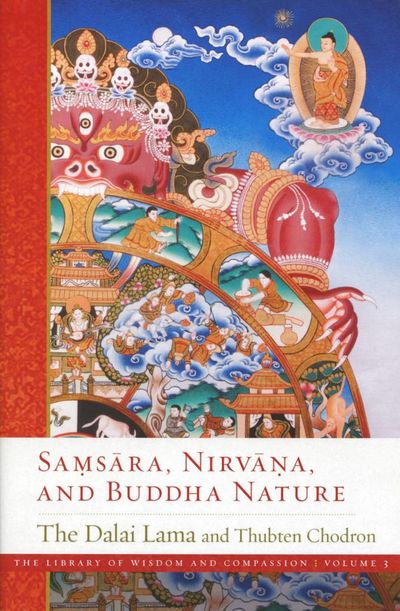- Preface by Bhikṣuṇī Thubten Chodron xiii
- Abbreviations xxi
- Introduction by His Holiness the Dalai Lama i
- 1. The Self, the Four Truths, and Their Sixteen Attributes 5
- Three Questions about the Self 5
- The Four Truths 10
- The Coarse and Subtle Four Truths 18
- The Sixteen Attributes of the Four Truths of Āryas 19
- 2. Revolving in Cyclic Existence: The Truth of Duḥkha 39
- Knowing Duḥkha for What It Is 39
- Realms of Existence 41
- Three Types of Duḥkha 47
- Feelings, Afflictions, and Duḥkha 50
- Six Disadvantages of Cyclic Existence 51
- Eight Unsatisfactory Conditions 53
- Examining True Duḥkha via Ten Points 54
- Our Human Value 57
- 3. True Origins of Duḥkha 63
- The Six Root Afflictions 64
- More Types ofDefilements 87
- Afflictions 88
- Underlying Tendencies 88
- Auxiliary Afflictions 92
- Fetters 97
- Pollutants 98
- Hindrances 99
- 4. Afflictions, Their Arising, and Their Antidotes 101
- Eighty-Four Thousand Afflictions 101
- The Order in Which Afflictions Arise 104
- Factors Causing Afflictions to Arise 106
- Feelings That Accompany Afflictions 109
- The Ethical Dimension of Afflictions 110
- Counterforces to the Afflictions 112
- Afflictions, Our Real Enemy 119
- 5. Afflictions and Karma, Their Seeds and Latencies 123
- Acquired and Innate Afflictions 124
- Coarse and Subtle Afflictions 126
- Seeds, Latencies, and Having-Ceased 126
- Latencies and Ideas in Other Religions and in Psychology 135
- Virtue, Nonvirtue, Merit, and Roots of Virtue 137
- 6. Karma, the Universe, and Evolution 141
- The Origin of the Universe 141
- Mind and the External World 144
- The Laws of Nature and the Law of Karma and Its Effects 148
- Karma and Our Present Environment 150
- Karma, Instinctual Behavior, and Our Bodies 152
- 7. Revolving in Cyclic Existence: The Twelve Links of Dependent
Origination 155- Dependent Arising 156
- How Cyclic Existence Occurs 158
- 1. Ignorance (avidyā) 159
- 2. Formative Action (saṃskāra karman) 165
- 3. Consciousness (vijñāna) 168
- 4. Name and Form (nāma-rūpa) 170
- 3. Six Sources (ṣaḍāyatana) 172
- 6. Contact (sparśa) 176
- 7. Feeling (vedanā) 176
- 8. Craving (tṛṣṇā) 179
- 9. Clinging (upādanā) 182
- 10. Renewed Existence (bhava) 183
- 11. Birth (jāti) 188
- 12. Aging or Death (jarāmaraṇa) 190
- 8. Dependent Origination: Cycling in Saṃsāra 193
- How the Twelve Links Produce a Life 193
- An Example 197
- Flexibility 200
- Pali Tradition: How We Cycle 200
- An Example from a Pāli Sūtra 202
- Who Revolves in Cyclic Existence? 204
- The Ultimate Nature of the Twelve Links 211
- 9. The Determination to Be Free 217
- The Benefits of Meditating on the Twelve Links 217
- Invigorating a Dry Dharma Practice 219
- Can a Leper Find Happiness? 222
- Compassion for Ourselves and Others 223
- The Demarcation of Generating the Determination to Be Free 227
- 10. Seeking Genuine Peace 231
- The "Ye Dharmā" Dhāraṇī 232
- Forward and Reverse Orders of the Afflictive and Purified Sides of
the Twelve Links 234 - Transcendental Dependent Origination (Pāli Tradition) 238
- Karma in Samsara and Beyond 249
- 11. Freedom from Cyclic Existence 233
- Stages Leading to Liberation and Full Awakening 254
- The Two Obscurations 259
- Nirvāṇa 262
- Pāli Tradition: Nirvāṇa 266
- Bodhi 274
- 12. The Mind and Its Potential 277
- The Mind's Potential 277
- Is Liberation Possible? 279
- Excellent Qualities Can Be Cultivated Limitlessly 281
- Afflictive Mental States and the Nature of the Mind 283
- The Equality of Saṃsāra and Nirvāṇa 284
- Levels of Mind 286
- 13. Buddha Nature 291
- The Mind's Potential according to the Pāli Tradition 291
- Ārya Disposition according to the Vaibhāṣikas and Sautrāntikas 292
- Buddha Nature according to the Cittamātra School 293
- Buddha Nature according to the Madhyamaka School 296
- Buddha Nature according to Tantra 301
- Nine Similes for Tathāgatagarbha 302
- Three Aspects of the Tathāgatagarbha 310
- Three Aspects of Buddha Disposition 314
- A Puzzle 315
- 14. Going Deeper into Buddha Nature 319
- The Three Turnings of the Dharma Wheel and Buddha Nature 319
- A Link between Sūtra and Tantra 322
- Nothing Is to Be Removed 325
- The Capacity Giving Rise to the Three Kāyas 327
- A Buddha's Nature Dharmakāya 328
- Pristine Wisdom Abiding in the Afflictions 330
- Causal Clear Light Mind 332
- What Continues to Awakening? 332
- Dzogchen and Mahāmudrā 334
- Are We Already Buddhas? 337
- Awareness of Our Buddha Nature Eliminates Hindrances 341
- 1. The Self, the Four Truths, and Their Sixteen Attributes 5
- Notes 343
- Glossary 353
- Further Reading 367
- Index 371
- About the Authors 409
No edit summary |
No edit summary |
||
| (2 intermediate revisions by 2 users not shown) | |||
| Line 2: | Line 2: | ||
|TileDescription=This is the third volume in the Dalai Lama’s definitive and comprehensive series on the stages of the Buddhist path. | |TileDescription=This is the third volume in the Dalai Lama’s definitive and comprehensive series on the stages of the Buddhist path. | ||
|BookPerson={{Book-person | |BookPerson={{Book-person | ||
|PersonPage=Dalai Lama, 14th | |||
|PersonName=The 14th Dalai Lama | |||
}}{{Book-person | |||
|PersonPage=Chodron, T. | |PersonPage=Chodron, T. | ||
|PersonName=Thubten Chodron | |PersonName=Thubten Chodron | ||
}} | }} | ||
|FullTextRead=No | |FullTextRead=No | ||
| Line 86: | Line 86: | ||
** {{i|10. Seeking Genuine Peace |231}} | ** {{i|10. Seeking Genuine Peace |231}} | ||
*** {{i|The "Ye Dharmā" Dhāraṇī |232}} | *** {{i|The "Ye Dharmā" Dhāraṇī |232}} | ||
*** {{i|Forward and Reverse Orders of the Afflictive and Purified Sides of the Twelve Links |234}} | *** {{i|Forward and Reverse Orders of the Afflictive and Purified Sides of<br>the Twelve Links |234}} | ||
*** {{i|Transcendental Dependent Origination (Pāli Tradition) |238}} | *** {{i|Transcendental Dependent Origination (Pāli Tradition) |238}} | ||
*** {{i|Karma in Samsara and Beyond |249}} | *** {{i|Karma in Samsara and Beyond |249}} | ||
| Line 110: | Line 110: | ||
*** {{i|Nine Similes for Tathāgatagarbha |302}} | *** {{i|Nine Similes for Tathāgatagarbha |302}} | ||
*** {{i|Three Aspects of the Tathāgatagarbha |310}} | *** {{i|Three Aspects of the Tathāgatagarbha |310}} | ||
*** {{i|Three Aspects | *** {{i|Three Aspects of Buddha Disposition |314}} | ||
*** {{i|A Puzzle |315}} | *** {{i|A Puzzle |315}} | ||
** {{i|14. Going Deeper into Buddha Nature |319}} | ** {{i|14. Going Deeper into Buddha Nature |319}} | ||
Latest revision as of 15:41, 5 November 2020
Knowledge of buddha nature reveals and reconciles the paradox of how the mind can be the basis for both the duhkha of samsara (the unpurified mind) and the bliss and fulfillment of nirvana (the purified mind). To illustrate this, Saṃsāra, Nirvāṇa, and Buddha Nature first takes readers through Buddhist thought on the self, the four truths, and their sixteen attributes. It then explains afflictions—including how they arise and their antidotes—followed by an examination of karma and cyclic existence, and, finally, a deep and thorough elucidation of buddha nature. Saṃsāra, Nirvāṇa, and Buddha Nature shows us how to purify our minds and cultivate awakened qualities.
This is the third volume in the Dalai Lama’s definitive and comprehensive series on the stages of the Buddhist path, The Library of Wisdom and Compassion. Volume 1, Approaching the Buddhist Path,contains introductory material that sets the context for Buddhist practice. Volume 2, The Foundation of Buddhist Practice, describes the important teachings that help us establish a flourishing Dharma practice. Saṃsāra, Nirvāṇa, and Buddha Nature can be read as the logical next step in this series or enjoyed on its own. (Source: Wisdom Publications)
| Citation | Dalai Lama, 14th, and Thubten Chodron. Saṃsāra, Nirvāṇa, and Buddha Nature. Library of Wisdom and Compassion 3. Somerville, MA: Wisdom Publications, 2018. |
|---|---|


